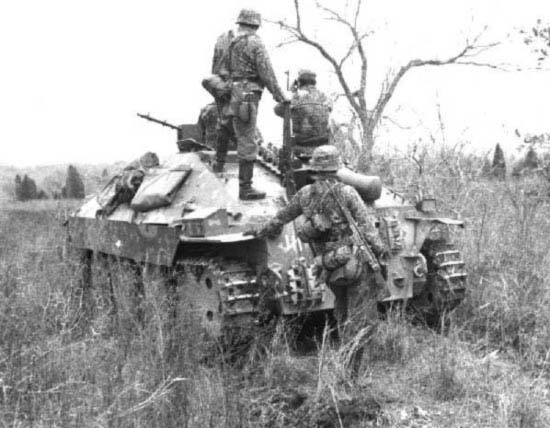Hetzer 38T
|
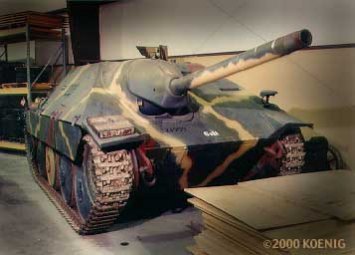 |
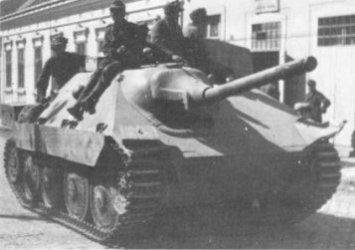 |
In March 1943, Col. Gen. Heinz Guderian demanded
a light tank destroyer to replace all existing Marders
and towed anti-tank artillery 75mm PaK 40 guns. The result of this
was the Panzerjägerprogram or G-13. The new vehicle resulting from
it was to equip tank destroyer units of infantry divisions. The Panzerkampfwagen
38(t) chassis was chosen as a base for this new Panzerjäger. It was
first known as "Leichtes Sturmgeschutz 38(t)", then "Jagdpanzer 38(t)
für 7.5cm Pak 39 L/48", and finally "Jagdpanzer 38 Hetzer". It appears
that the name Hetzer was not an official name but used by troops and
then used in post-war publications. On December 17, 1943, designs
were ready and, on January 24, 1944, a wooden mock-up was finished.
In March 1944, the first three proto-types were produced by BMM (Boehmish-Mährische
Maschinenfabrik) and it was decided to start production. From March
to April of 1944, prototypes were extensively tested, while preparations
for production were made at BMM (Praga/CKD-Ceskomoravska Kolben Danek)
in Prague and then at Skoda Works at Pilsen.
On April 20, 1944, the Hetzer was shown to Hitler and other leaders
of the Third Reich at Arys. At this time, the new Panzerjäger was
designated Jagdpanzer 38(t) Hetzer , Sd.Kfz.138/2, but it was also
known simply as Panzerjäger 38(t). Production started, in April 1944,
at BMM and, in Septem-ber, at Skoda. 2,584 were produced by May 1945.
In April 1944, BMM produced the first 20 Hetzers and monthly production
increased greatly thereafter. Eventually, plants in Prague, Pilsen,
Königgrätz, Boehm, and Breslau made the Hetzer. Late-war production
plans called for 1,000 Hetzers per month, starting in mid-1945.
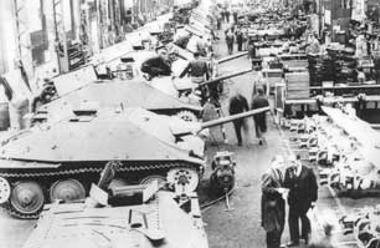
Hetzer was built on the Panzerkampfwagen 38(t)'s
widened chassis with modified suspension (larger road-wheels from
Praga TNH n.A prototype reconnaissance tank) and up-rated engine.
The new engine was 160hp Praga AC/2 6-cylinder engine controlled by
Praga-Wilson gearbox (5 forward and 1 reverse gear). Chassis was modified
in order to accommodate larger gun and thicker armour than regular
Panzerkampfwagen 38(t) tank. Hetzer carried 320 litres of fuel in
two tanks, which gave it maximum range of 177km. Its combat weight
was 16 metric tons and it could travel at maximum speed of some 42km/h.
Hetzer's tracks had 96 links per side with 350mm wide tracks with
track surface contact of 2.72m. Hetzer had a low well-sloped hull
of welded construction. Hull had 60mm thick frontal plate, 8mm thin
roof and rear armour and 20mm thin side armour. All armoured plates
sloped inwards. In addition, Hetzer was fitted with small 5mm side
skirts (Schuerzen). It was armed with 75mm Pak 39 L/48 gun with limited
traverse (5 degrees to the left and 11 degrees to the right) and elevation
(-6 degrees to +10 degrees). The gun was mounted with Sfl.Z.F.1a gun
sight. Main armament was protected by 60mm cast gun mantlet - Saukopf.
Heavy gun and thick frontal plate overloaded the front but it was
later corrected by the use of strengthen suspension.
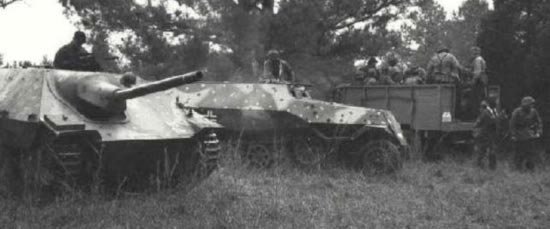
Hetzers were to equip tank destroyer units
(Panzerjaeger Abteilung / Panzerjaeger Kompanie) of infantry divisions,
panzergrenadier divisions and independent units. Main center for training
of future Hetzer crews was located at Milovice - Panzerjaegerschule.
Majority was issued to Wehrmacht infantry divisions (starting in July
of 1944) with 15th and 76th Infantry Division) and Volksgrenadier
divisions. Hetzers were also issued as replacements for Marders and
other Jagdpanzers to other units.
In last months of the war, Hetzers were often issued as replacements
for lost battle tanks, a role they were not intended for (e.g. Panzer
Division Kurmark and Feldherrnhalle). Some were issued to improvised
units created in the last days of the war from various military personnel.
Hetzer was also one of the last German armoured fighting vehicles
that remained in production and was issued to the troops until the
last days of the war.
Hetzers equipped all types of formations of the Wehrmacht, Waffen-SS
(10 divisions), Luftwaffe (1 division), Kriegsmarine (2 divisions),
RAD (3 divisions) and ROA (Russian Liberation Army) and saw service
on all fronts. Large number of Hetzers took part in the German offensive
in the Ardennes in late 1944.
First Hetzers entered service with 731st and 743rd Heeres Panzerjager
Abteilung in May/June of 1944. Each unit received 45 Hetzers and both
units saw service on the Eastern Front. Following, Hetzers were issued
to three more independent units - 741st (1944), 561st (1945) and 744th
Heeres Panzerjager Abteilung (1945). Waffen-SS received small number
of Hetzer and first unit to be issued with Hetzers was 8th SS Cavalry
Division Florian Geyer in September of 1944. Some 200 were issued
in 1944 and 1945 to 10 Waffen SS divisions, mainly panzergrenadier.
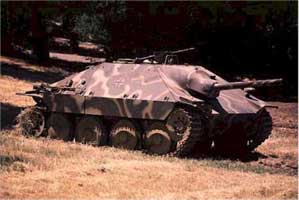 |
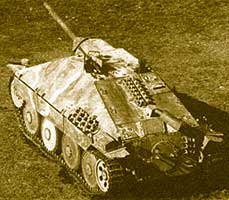 |
Hetzer's interior was cramped for the four-man crew (commander, gunner, loader and driver), because of its sloped armour and low silhouette. Interior was divided into two compartments - engine and fighting/crews compartment. Gunner and loader were located on the left side of the gun; commander was in the rear on the right side of the gun, while the driver in front of the vehicle on the left side of the gun. Crew communicated using the intercom system and 10-watt FuG5 radio set. Hetzers completed as command vehicles - Befehlswagen 38(t) Hetzer had additional 30-watt FuG8 radio set.
Commander could observe the battlefield using periscopic binoculars, through an open hatch in the roof but overall, his field of view was limited. The low silhouette made it a difficult to spot and at the same time gave Hetzer an advantage of attacking first. 75mm anti-tank gun was mounted far to the right (380mm of centre) what created difficulties for the crew (especially the gunner and loader), since the weapon itself was designed to be loaded from the right, resulting in the low rate of fire. Small space inside allowed only 40-41 rounds of 75mm and 600 round of 7.92mm ammunition to be stored. Later on storage space was increased and 45 rounds of 75mm ammunition were carried.
Panzer Units Bulletin from October of 1944 - "...Light tank destroyer Jagdpanzer 38 proved itself in combat. Crews are proud of them (Hetzers) and they as well as the infantry have confidence in them. The most praised is the option of all-around fire from the machine gun. Great firepower, low profile and overall shape proved suitability to fullfil two main tasks: fighting enemy tanks and direct support of the infantry in defence and offense. It occured that single company in short time destroyed 20 enemy tanks without any losses. One unit destroyed 57 enemy tanks (including 2 Stalins at 800m (Soviet IS-2)) without any losses. This same unit arrived in the combat area after traveling during the day the distance of 160km without any breakdowns...Front armor can withstand Soviet 76.2mm gun fire. Current losses are results of side and rear plates being hit..."
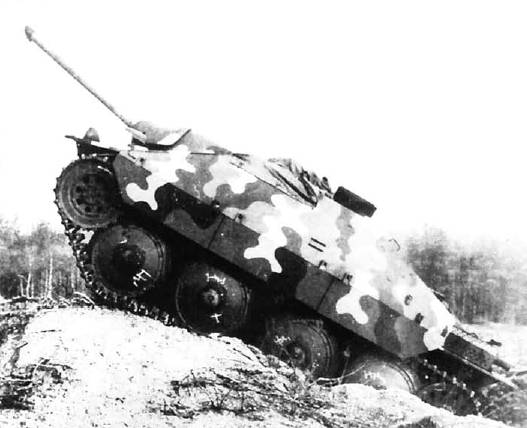 |
"...During one of fire duels of 4 self-propelled guns (Hetzers) from our company (3rd company of H.Pz.Jg.Abt 731) with single IS 122 (Soviet IS-2) at the distance of 1200m it was revealed that 10 rounds fired by the enemy tank at the company commander's vehicle fell 100m short of their target. Company commander right away ordered one of the guns (Hetzers) to move to the right and use the depression attacking from the side. Six rounds fired from that gun (Hetzer) hit the side armor and set IS 122 (IS-2) on fire...".
Hetzer was constantly modified and detailed during production and there are numerous differences between early, mid and later production vehicles. Most of the modifications were made in order to simplify production and to cope with shortages of materials. Modifications included: modified commander's and access hatches, lighter gun mantlet (30mm), modified road wheels, various types of idlers, strengthened suspension, muffler, etc.
In the Summer of 1944, it was planned to deliver 30 Hetzers to the Romanian Army but instead they were delivered to the Wehrmacht. From December of 1944 to January of 1945, Germany exported 75 to 100 Hetzers to Hungary, the only other user of Hetzer during the war. Few captured Hetzers were briefly used by Polish, American, Soviet and Bulgarian units. The probably the most notable Hetzer (from 743rd Panzerjager Abteilung) was that captured by Polish Home Army during Warsaw Uprising on August 2nd of 1944, which was repaired and nicknamed "Chwat" (Gallant/Brave Fellow) and was used against its previous owners.
